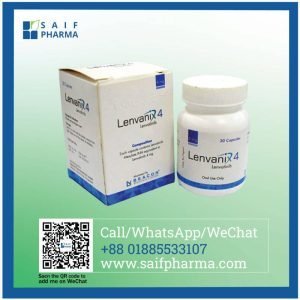Pazonib 200 mg (Pazopanib) is indicated for the treatment of cases with advanced renal cell melanoma (RCC). Pazopanib is indicated for the treatment of cases with advanced soft towel sarcoma (STS) who have entered previous chemotherapy. The efficacity of Pazopanib for the treatment of cases with adipocytic STS or gastrointestinal stromal excrescences has not been demonstrated.
Pharmacology
Pazopanib is a multi-tyrosine kinase asset of vascular endothelial growth factor receptor (VEGFR)-1, VEGFR 2, VEGFR-3, platelet-deduced growth factor receptor (PDGFR)-α and-β, and fibroblast growth factor receptor (FGFR)-1 and-3, cytokine receptor ( Tackle), interleukin-2 receptor-inducible T- cell kinase (Itk), lymphocyte-specific protein tyrosine kinase (Lck), and transmembrane glycoprotein receptor tyrosine kinase (c-Fms). In vitro, Pazopanib inhibited ligand-convinced autophosphorylation of VEGFR-2, Tackle, and PDGFR-β receptors.
Immersion Pazopanib is absorbed orally with the median time to achieve peak attention of 2 to 4 hours after the cure. Diurnal dosing at 800 mg results in geometric mean AUC and C maximum of mcg/ mL and 58.1 mcg/ mL ( original to 132 µM), independently. There was no harmonious increase in AUC or C maximum at Pazopanib boluses above 800 mg.
The distribution List of Pazopanib to mortal tube protein in vivo was lesser than 99 with no attention dependence over the range of 10 to 100 mcg/ mL. In vitro, studies suggest that Pazopanib is a substrate for P-GP and BCRP.
Metabolism In vitro studies demonstrated that Pazopanib is metabolized by CYP3A4 with a minor donation from CYP1A2 and CYP2C8.
Elimination Pazopanib has a mean half-life of 30.9 hours after administration of the recommended cure of 800 mg. Elimination is primarily via feces with renal elimination accounting for lower than 4 of the administered cure.
Lozenge & Administration
The recommended starting cure of Pazopanib is 800 mg orally formerly daily without food (at least 1 hour before or 2 hours after a mess). The cure of Pazopanib shouldn’t exceed 800 mg. Tablets shouldn’t be crushed due to the eventuality of an increased rate of immersion which may affect systemic exposure. However, it shouldn’t be taken if it’s lower than 12 hours until the coming cure If cure is missed. Or, as directed by the registered croakers.
Interaction
Medicines that Inhibit or Induce Cytochrome P450 3A4 Enzymes In vitro studies suggested that the oxidative metabolism of Pazopanib in mortal liver microsomes is intermediated primarily by CYP3A4, with minor benefactions from CYP1A2 and CYP2C8. Thus, impediments and corrupters of CYP3A4 may alter the metabolism of Pazopanib.
CYP3A4 Impediments Coadministration of Pazopanib with strong impediments of CYP3A4 (e.g., Ketoconazole, Ritonavir, Clarithromycin) increases Pazopanib attention and should be avoided. Consider an alternate attendant drug with no or minimum eventuality to inhibit CYP3A4. However, reduce the cure of Pazopanib to 400 mg, If coadministration of a strong CYP3A4 asset is warranted. Grapefruit or grapefruit juice should be avoided as it inhibits CYP3A4 exertion and may also increase tube attention of Pazopanib.
CYP3A4 Corrupters CYP3A4 corrupters, similar to Rifampin, may drop tube Pazopanib attention. Consider an alternate attendant drug with no or minimum enzyme induction eventuality. Pazopanib shouldn’t be used if the habitual use of strong CYP3A4 corrupters can not be avoided.
Medicines that Inhibit Transporters In vitro studies suggested that Pazopanib is a substrate of P-glycoprotein (P-GP) and bone cancer resistance protein (BCRP). Thus, immersion and posterior elimination of Pazopanib may be told by-products that affect P-GP and BCRP. Attendant treatment with strong impediments of P-GP or BCRP should be avoided due to the threat of increased exposure to Pazopanib. The selection of indispensable attendant medicinal products with no or minimum eventuality to inhibit P-GP or BCRP should be considered.
Goods of Pazopanib on CYP Substrates Results from medicine-medicine commerce trials conducted in cancer cases suggest that Pazopanib is a weak asset of CYP3A4, CYP2C8, and CYP2D6 in vivo, but had no effect on CYP1A2, CYP2C9, or CYP2C19. Attendant use of Pazopanib with agents with narrow remedial windows that are metabolized by CYP3A4, CYP2D6, or CYP2C8 isn’t recommended. Coadministration may affect in inhibition of the metabolism of these products and produce the eventuality of serious adverse events.
Effect of Attendant Use of Pazopanib and Simvastatin Concomitant use of Pazopanib and Simvastatin increases the prevalence of ALT elevations. Across monotherapy trials with Pazopanib, ALT lesser than 3 x ULN has been reported in126/895 (14) cases who didn’t use statins, compared with11/41 (27) of cases who had attendant use of simvastatin. However, follow dosing guidelines for Pazopanib or consider druthers to Pazopanib, If a case entering attendant Simvastatin develops ALT elevations. Alternatively, consider discontinuing Simvastatin. Inadequate data are available to assess the threat of attendant administration of indispensable statins and Pazopanib.
Contraindications
It’s contraindicated in cases with known acuity to Pazopanib or any other factors of this product.
Side Goods
Common side goods of Pazopanib include
Hepatic Toxin and Hepatic Impairment
QT Extension and Torsades de Pointes
Cardiac Dysfunction
Hemorrhagic Events
Arterial and Venous Thromboembolic Events
Thrombotic Microangiopathy
Gastrointestinal Perforation and Fistula
Interstitial Lung Complaint/ Pneumonitis
Reversible Posterior Leukoencephalopathy Syndrome
Hypertension
Hypothyroidism
Proteinuria
Tumor Lysis Pattern
Infection
Increased Toxin with Other Cancer Therapy
Gestation & Lactation
Pazopanib can beget fetal detriment when administered to a pregnant woman. There are no available data on pregnant women to inform a medicine-associated threat. Pregnant women or women should be advised of the travail eventuality of the implicit threat to a fetus. There’s no information regarding the presence of Pazopanib or its metabolites in mortal milk, their goods on the breastfed child, or on milk products. Because of the eventuality of serious adverse responses in breastfed babies from Pazopanib, a lactating woman should be advised not to breastfeed during treatment with Pazopanib and for 2 weeks after the final cure.
Preventives & Warnings
Hepatic Toxin and Hepatic Impairment In clinical trials with Pazopanib, hepatotoxicity, manifested as increases in serum transaminases (alanine transferase (ALT), aspartate aminotransferase (AST)) and bilirubin, which was observed. This hepatotoxicity can be severe and fatal. Cases aged 65 times are a lesser threat for hepatotoxicity. Transaminase elevations do beforehand in the course of treatment (92.5 of all transaminase elevations of any grade passed in the first 18 weeks).
QT Extension and Torsades De Pointes In the RCC trials of Pazopanib, QT extension ( lesser than or equal to 500 msec) was linked to routine electrocardiogram (ECG) monitoring in 2 (11/558) of cases. Torsades de pointes passed in lower than 1 (2/977) of cases who entered Pazopanib in the monotherapy trials. Pazopanib should be used with caution in cases with a history of QT interval extension, in cases taking antiarrhythmics or other specifics that may protract QT intervals, and in those with applicable-existing cardiac complaints. When using Pazopanib, birth and periodic monitoring of ECGs and conservation of electrolytes (e.g., calcium, magnesium, potassium) within the normal range should be performed.
Use in Special Populations
Ladies Pazopanib can beget fetal detriment when administered to a pregnant woman. Ladies of reproductive eventuality should be advised to use effective contraception during treatment and for at least 2 weeks after the last cure of Pazopanib.
Males To avoid implicit medicine exposure to pregnant mates and womanish mates of reproductive eventuality, manly cases ( including those who have had vasectomies) with womanish mates of reproductive eventuality should be advised to use condoms during treatment with Pazopanib and for at least 2 weeks after the last cure.
Pediatric Use The safety and effectiveness of Pazopanib in pediatric cases haven’t been established.
Overdose Goods
Pazopanib boluses up to 2000 mg have been estimated in clinical trials. Cure-limiting toxin (Grade 3 fatigue) and Grade 3 hypertension were each observed in 1 of 3 cases cured at 2000 mg daily and 1000 mg daily, independently. Treatment of overdose with Pazopanib should correspond to general probative measures. There’s no specific cure for the overdosage of Pazopanib. Hemodialysis isn’t anticipated to enhance the elimination of Pazopanib because Pazopanib isn’t significantly really excreted and is largely bound to tube proteins.
Storage Conditions
Store below 30 ° C in a cool and dry place, down from the sun. Keep out of reach of children.







